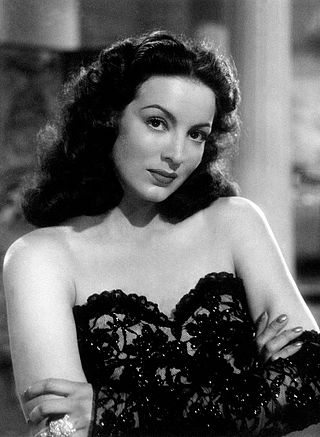
María de los Ángeles Félix Güereña was a Mexican actress and singer. Along with Pedro Armendáriz and Dolores del Río, she was one of the most successful figures of Latin American cinema in the 1940s and 1950s. Considered one of the most beautiful actresses of the Golden Age of Mexican cinema, her strong personality and taste for finesse garnered her the title of diva early in her career. She was known as La Doña, a name derived from her character in Doña Bárbara (1943), and María Bonita, thanks to the anthem composed exclusively for her as a wedding gift by her second husband, Agustín Lara. Her acting career consists of 47 films made in Mexico, Spain, France, Italy and Argentina.

The music of Mexico is highly diverse, featuring a wide range of musical genres and performance styles. It has been influenced by a variety of cultures, primarily deriving from Europeans, Indigenous, and Africans. Music became an expression of Mexican nationalism starting in the nineteenth century.
Bolero is a genre of song which originated in eastern Cuba in the late 19th century as part of the trova tradition. Unrelated to the older Spanish dance of the same name, bolero is characterized by sophisticated lyrics dealing with love. It has been called the "quintessential Latin American romantic song of the twentieth century".

Chavela Vargas was a Costa Rican singer. She gained widespread recognition for her distinctive interpretations of Mexican rancheras. However, her impact extends beyond this genre, encompassing various styles within popular Latin American music.
"You Belong to My Heart" is the name of an English-language version of the Mexican Bolero song "Solamente una vez". This song was composed by Mexican songwriter Agustín Lara and originally performed by singer Ana María González and tenor José Mojica in the 1941 film Melodías de América.

Pedro Vargas Mata was a Mexican tenor and actor, from the golden age of Mexican cinema, participating in more than 70 films. He was known as the "Nightingale of the Americas", "Song Samurai" or "Continental Tenor".

Graciela Naranjo was a Venezuelan singer and actress. A radio, cinema and television pioneer in her homeland, she made her professional debut as a bolero singer in 1931. From the thirties onward her fame as a singer grew, she appeared in films and had her own TV show in an incredibly long career that extended from 1931 through 2000. She is the mother of Alberto Naranjo, a Venezuelan musician.
Javier Ruiz Rueda was a Mexican composer and writer. He was born in Mexico City.

Rodrigo Alvarez de la Cadena is a Mexican singer, performer, songwriter, radio host and musician. He is best known for his performances with a variety of worldwide artists and performers. He is also the host of a live radio show in which he performs and introduces audiences to his music.

Daniel Santacruz is a Dominican singer, songwriter, and music producer. Born in New Jersey and raised in the Dominican Republic to a Cuban father and a Dominican mother, Santacruz is a Latin Grammy Award winner.

María Teresa Lara Aguirre del Pino was a Mexican lyricist and composer.

Gonzalo Curiel Barba was a Mexican film composer. He was active during the Golden Age of Mexican cinema.
Ana María Fernández Pomar was a Mexican singer and the first female performer of Agustín Lara's boleros. One of the great stars of Mexican revues of the 1930s, she was also one of the first singers to perform on Mexico City's famous XEW radio station, where announcer Pedro de Lille introduced her as "La Cancionera del Estilo Único". She recorded several singles for the RCA Víctor and Okeh labels between 1931 and 1942.
Néstor Mesta Cháyres was an acclaimed tenor in Mexico and a noted interpreter of Spanish songs, boleros and Mexican romantic music on the international concert stage. He was widely commended for his artistic renditions of the works of Agustín Lara and María Grever and was nicknamed "El Gitano de México".

Juan Nepomuceno Arvizu Santelices, was an acclaimed lyric tenor in Mexico and a noted interpreter of the Latin American bolero and tango on the international concert stage, on the radio and in film. He was widely noted for his interpretations of the works of Agustin Lara and María Grever and was nicknamed "The Tenor With the Silken Voice".

Eugenia León is a Mexican singer. In 1985, she won first place at the prestigious OTI Festival in Seville, Spain with the theme "El Fandango Aquí" by Marcial Alejandro. A recipient of the Latin Grammy Lifetime Achievement Award, she has had a career spanning more than 35 years and 26 recorded albums, of which several million copies have been sold. She has performed in some of the most important venues in Mexico, such as the Palacio de Bellas Artes, the Auditorio Nacional, the Sala Nezahualcóyotl, the Teatro de la Ciudad, and the Cervantino Festival.
Lydia Gómez Valdivia, known as Lydia Fernández, was a Mexican singer who began her career in the 1930s and became the first female performer of the songs of composer Gonzalo Curiel. She also was among the first performers of Mexican bolero songs.

Noche Bohemia is the debut album by Mexican singer Chavela Vargas, credited on the album as "Chabela Vargas". It was released in 1961 on the Orfeón label. Vargas was accompanied on the recording by guitarist Antonio Bribiesca. Noche Bohemia was the first of more than 80 records by Vargas. The album included "Macorina" which became one of Vargas' best known songs.

Chavela Vargas is the second album by Mexican singer Chavela Vargas. It was released in 1961 on the RCA Victor label. Vargas was accompanied on the recording by the Cuarteto Lara Foster. The album included "La Llorona" which became one of Vargas' best known songs.

Rosa is an album of bolero music by Mexican composer and singer Agustín Lara su piano y sus ritmos. It was released in 1958 on the RCA Victor label.

















